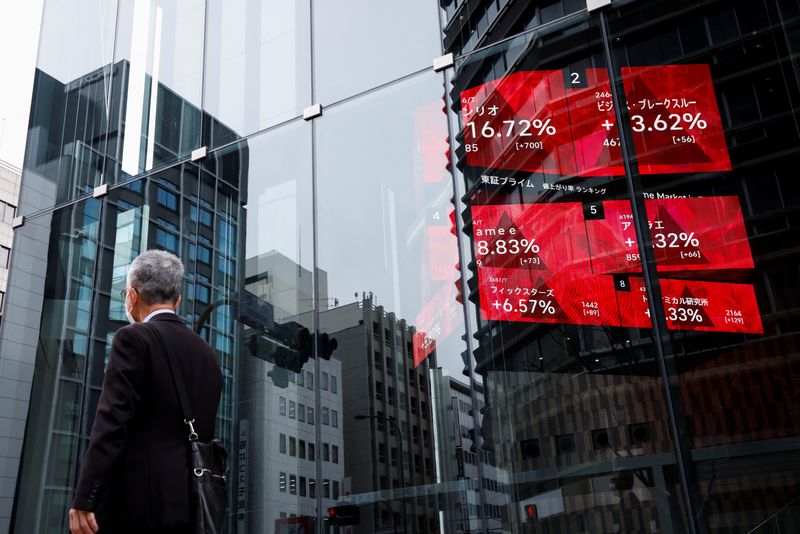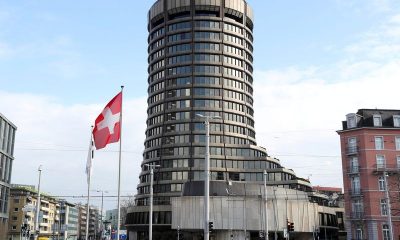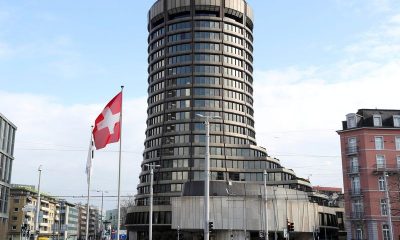Economy
Wall Street loses steam as Fed, China worries keep yields higher


© Reuters. FILE PHOTO: A man walks past an electronic board showing stock visualizations outside a brokerage, in Tokyo, Japan, March 17, 2023. REUTERS/Androniki Christodoulou
By Huw Jones and Pete Schroeder
LONDON/WASHINGTON (Reuters) -Global shares were stuck around two-month lows on Friday as Wall Street opened lower, capping a week that saw U.S. yields soar to near 16-year peaks as investors prepped for interest rates to remain higher for longer.
U.S. stocks opened weakly in early trading on a slow day for economic data, adding to losses posted earlier in the week.
The was down 0.11% shortly after the open, with the slipping 0.31%and the falling 0.7%.
The MSCI All Country stock index was down 0.56%, hitting its lowest since early June after falling 5.85% during August, though it remains 10% up for the year.
“The US calendar is empty today and the focus will likely be on bond market dynamics after back-end yields touched fresh multi-year highs yesterday,” ING bank analysts said.
In bond markets, yields on benchmark 10-year U.S. Treasuries stepped back slightly after flirting with 16-year highs earlier in the week, as investors adjusted for the possibility Fed officials may opt to keep rates higher for longer after a steady diet of strong economic news out of the U.S.
Ten-year yields were last at 4.251%, after reaching 4.328% on Thursday. A break above the 4.338% level reached in October would bring yields to their highest since November 2007.
The greenback looked well-positioned for a fifth consecutive week of gains, its longest winning streak for 15 months, helped by the prospect of U.S. interest rates remaining high or rising even further, and a safe haven in the face of growing risks in China. The , which tracks the currency versus a basket of six competitors, was down 0.14%.
Minutes from the Federal Reserve this week showed most members of the rate-setting committee continued to see significant upside risks to inflation, suggesting more hikes are in the pipeline.
Attention now turns to the Fed and other top central banks’ annual gathering in Jackson Hole, Wyoming, next week, with investors set to scrutinise a speech from Fed Chair Jerome Powell on Aug. 25 for fresh clues on what comes next for interest rates.
“We view the event as a good opportunity for Powell to start laying the ground for the next step in the Fed’s policy guidance: no longer focused on how many hikes to expect, but rather on rates remaining ‘higher for longer,'” said TD Securities analysts in a note.
Markets are already scaling back rate cuts bets next year.
Crude oil looked poised to snap a seven-week winning streak as China’s slowing economic growth clouded the picture for demand.
was last up 0.15% at $84.25 a barrel. jumped 0.41% to $80.72 a barrel.
There was little market response to news of a package of measures from China’s securities regulator to revive a sinking stock market.
Investors were keeping a close eye on the liquidity crunch that appeared to be spreading to China’s vast shadow banking sector, with Zhongzhi, a major Chinese asset manager, telling investors it needs to restructure its debt.
The yen was trading at 145.32 against the dollar, having been hammered this week to a nine-month low of 146.56 per dollar as yield differentials between the U.S. and Japan widened. It is near levels that sparked an intervention by Japanese authorities late last year.
Gold was 0.2% higher at $1,893 per ounce.
Economy
Russian central bank says it needs months to make sure CPI falling before rate cuts -RBC


© Reuters. Russian Central Bank Governor Elvira Nabiullina attends a news conference in Moscow, Russia June 14, 2019. REUTERS/Shamil Zhumatov/File Photo
MOSCOW (Reuters) – Russia’s central bank will need two to three months to make sure that inflation is steadily declining before taking any decision on interest rate cuts, the bank’s governor Elvira Nabiullina told RBC media on Sunday.
The central bank raised its key interest rate by 100 basis points to 16% earlier in December, hiking for the fifth consecutive meeting in response to stubborn inflation, and suggested that its tightening cycle was nearly over.
Nabiullina said it was not yet clear when exactly the regulator would start cutting rates, however.
“We really need to make sure that inflation is steadily decreasing, that these are not one-off factors that can affect the rate of price growth in a particular month,” she said.
Nabiullina said the bank was taking into account a wide range of indicators but primarily those that “characterize the stability of inflation”.
“This will take two or three months or more – it depends on how much the wide range of indicators that characterize sustainable inflation declines,” she said.
The bank will next convene to set its benchmark rate on Feb. 16.
The governor also said the bank should have started monetary policy tightening earlier than in July, when it embarked on the rate-hiking cycle.
Economy
China identifies second set of projects in $140 billion spending plan


© Reuters. FILE PHOTO: Workers walk past an under-construction area with completed office towers in the background, in Shenzhen’s Qianhai new district, Guangdong province, China August 25, 2023. REUTERS/David Kirton/File Photo
SHANGHAI (Reuters) – China’s top planning body said on Saturday it had identified a second batch of public investment projects, including flood control and disaster relief programmes, under a bond issuance and investment plan announced in October to boost the economy.
With the latest tranche, China has now earmarked more than 800 billion yuan of its 1 trillion yuan ($140 billion) in additional government bond issuance in the fourth quarter, as it focuses on fiscal steps to shore up the flagging economy.
The National Development and Reform Commission (NDRC) said in a statement on Saturday it had identified 9,600 projects with planned investment of more than 560 billion yuan.
China’s economy, the world’s second largest, is struggling to regain its footing post-COVID-19 as policymakers grapple with tepid consumer demand, weak exports, falling foreign investment and a deepening real estate crisis.
The 1 trillion yuan in additional bond issuance will widen China’s 2023 budget deficit ratio to around 3.8 percent from 3 percent, the state-run Xinhua news agency has said.
“Construction of the projects will improve China’s flood control system, emergency response mechanism and disaster relief capabilities, and better protect people’s lives and property, so it is very significant,” the NDRC said.
The agency said it will coordinate with other government bodies to make sure that funds are allocated speedily for investment and that high standards of quality are maintained in project construction.
($1 = 7.1315 renminbi)
Economy
Russian central bank says it needs months to make sure CPI falling before rate cuts -RBC


© Reuters. Russian Central Bank Governor Elvira Nabiullina attends a news conference in Moscow, Russia June 14, 2019. REUTERS/Shamil Zhumatov/File Photo
MOSCOW (Reuters) – Russia’s central bank will need two to three months to make sure that inflation is steadily declining before taking any decision on interest rate cuts, the bank’s governor Elvira Nabiullina told RBC media on Sunday.
The central bank raised its key interest rate by 100 basis points to 16% earlier in December, hiking for the fifth consecutive meeting in response to stubborn inflation, and suggested that its tightening cycle was nearly over.
Nabiullina said it was not yet clear when exactly the regulator would start cutting rates, however.
“We really need to make sure that inflation is steadily decreasing, that these are not one-off factors that can affect the rate of price growth in a particular month,” she said.
Nabiullina said the bank was taking into account a wide range of indicators but primarily those that “characterize the stability of inflation”.
“This will take two or three months or more – it depends on how much the wide range of indicators that characterize sustainable inflation declines,” she said.
The bank will next convene to set its benchmark rate on Feb. 16.
The governor also said the bank should have started monetary policy tightening earlier than in July, when it embarked on the rate-hiking cycle.

 Forex3 years ago
Forex3 years agoForex Today: the dollar is gaining strength amid gloomy sentiment at the start of the Fed’s week

 Forex3 years ago
Forex3 years agoUnbiased review of Pocket Option broker

 Forex3 years ago
Forex3 years agoDollar to pound sterling exchange rate today: Pound plummeted to its lowest since 1985

 Forex3 years ago
Forex3 years agoHow is the Australian dollar doing today?

 Cryptocurrency3 years ago
Cryptocurrency3 years agoWhat happened in the crypto market – current events today

 World3 years ago
World3 years agoWhy are modern video games an art form?

 Commodities3 years ago
Commodities3 years agoCopper continues to fall in price on expectations of lower demand in China

 Economy3 years ago
Economy3 years agoCrude oil tankers double in price due to EU anti-Russian sanctions

























